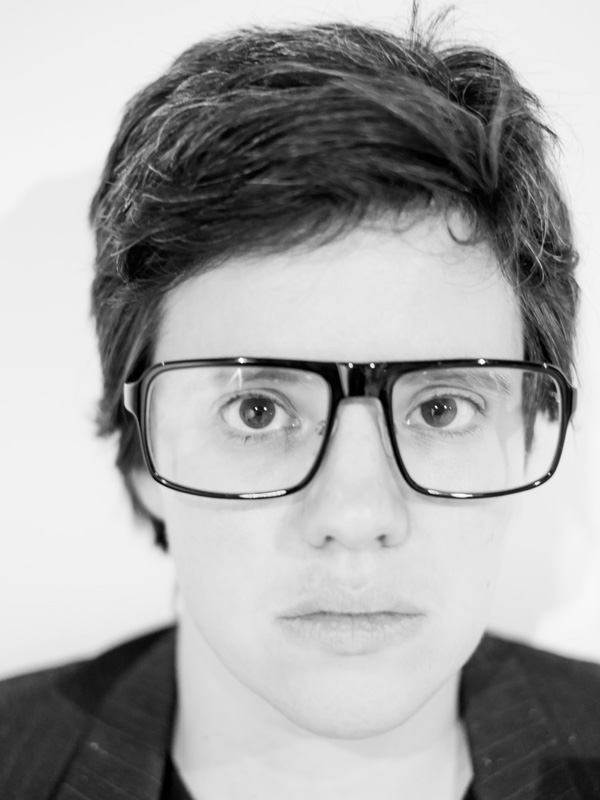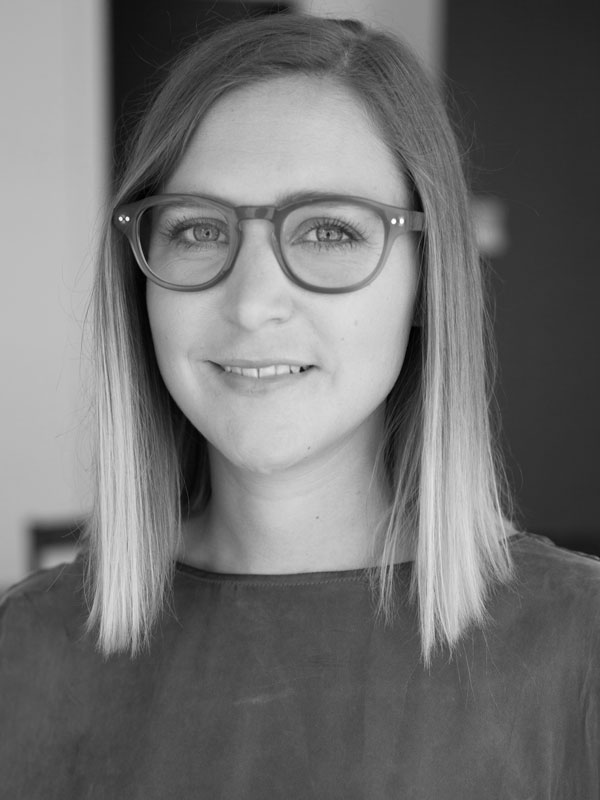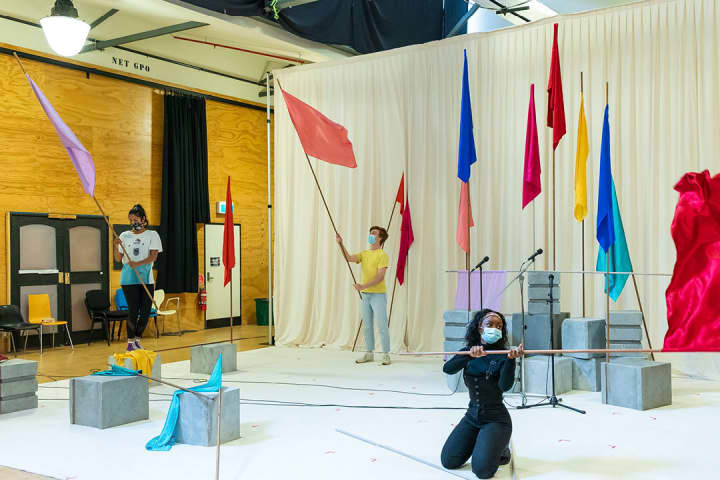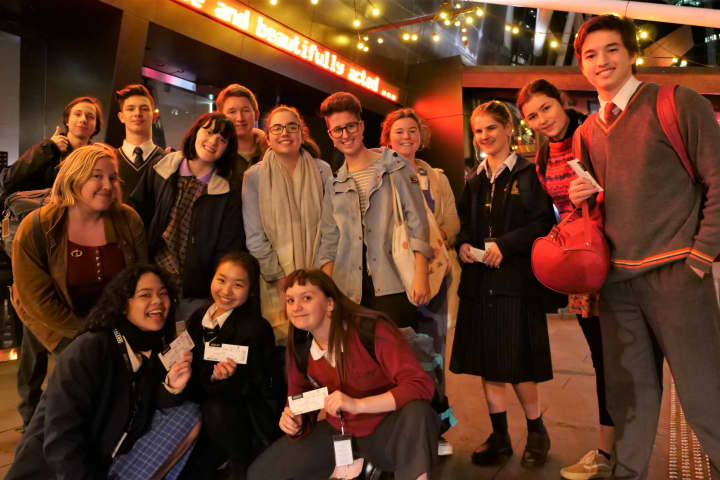Working alongside director Petra Kalive, the Hungry Ghosts creative team includes Darius Kedros (Composer & Sound Designer), Emma Valente (Lighting Designer), Eugyeene Teh (Set Designer) and Sophie Woodward (Costume Designer).
Hear from the design team below, then download our Education Packs to learn more about their work on Hungry Ghosts.
Darius Kedros (Composer & Sound Designer)
 Darius Kedros has had a lot of freedom to experiment with sound design playback elements in Hungry Ghosts. He describes the role of sound in this play as ‘somewhat nebulous’.
Darius Kedros has had a lot of freedom to experiment with sound design playback elements in Hungry Ghosts. He describes the role of sound in this play as ‘somewhat nebulous’.
How would you describe the sound design you’ve created for Hungry Ghosts?
The concept we’ve developed for Hungry Ghosts is that the play exists on various levels; inside the vacuum created by the snap of a pistol shrimp’s claw; inside the mind of the protagonist; and inside the minds of the souls lost in the flight MH370 airplane that disappeared in 2014. These worlds are suggestive, rather than explicit, rarely if ever telling us where we are at any one time, and so the sound design is correspondingly esoteric and stylised.
What are some examples of sounds that you use?
The sound design in the play is largely non-diegetic, but with a smattering of identifiable sounds that help shift the place and or pace, and therefore add dynamics to the work which rarely or arguably ever really exists in any single identifiable location. I’ve made the vast majority of the sounds from my own field recordings, including contact microphone recordings, and various hydrophone recordings from the sea and the Yarra River.
Is there a particular moment in the play that you’re especially excited about?
We’ve used a contact microphone hidden in the set that will make that piece of set come alive when it’s moved, and so become part of the sound design, but in a non-diegetic way. I’m excited to be playing with that, and I’m also looking forward to working closely with Emma Valente, the lighting designer, to add jarring sound and light elements to the play.
Emma Valente (Lighting Designer)
 Emma Valente describes her lighting design for Hungry Ghosts as ‘dark and moody’, transforming the pods into aeroplanes, prawns, coffins, and airports. ‘This kind of transformation is a collaboration between all the elements,’ says Valente.
Emma Valente describes her lighting design for Hungry Ghosts as ‘dark and moody’, transforming the pods into aeroplanes, prawns, coffins, and airports. ‘This kind of transformation is a collaboration between all the elements,’ says Valente.
What opportunities/challenges are presented by the script or other design aspects?
The pods are very challenging to light as you can only light them from the inside, if you shine light on them from the outside the light bounces off the Perspex and into the audience’s eyes. The play is also very challenging, because there is a lot of information to transmit. This means that the designers need to make sure there is enough going on to make the show interesting without undermining the text, or making it difficult or confusing to understand.
How is the integrated LED (Light Emitting Diode) lighting used in the set?
We are using LED inside the set pieces in two ways. There are the visible batons that are representing a horizon line, or a runway. These fixtures are used to create architectural divisions, metaphor and mood. Then there are small strips in the front of the set pieces to light the actors’ faces. These are more practical fixtures. LED strip is made up of a red chip, blue chip, green chip and a cool white chip. This means, by mixing the different colours I can pretty much make any colour I want to.
How did you arrive at your design choices? What influences have there been, and what practical considerations?
I have been inspired by different pictures of being underwater and above the clouds. In my colour palette I’m trying to conjure these two images. Darius (Composer & Sound Designer) and I are also trying to suggest the moment of the plane crash in different ways during the transitions. For these moments I have been looking at the way light acts inside aeroplanes – the way fluorescents flicker, how day light falls through the windows etc.
Eugyeene Teh (Set Designer)
 Eugyeene Teh’s set design draws its concept from the script itself. ‘The fluidity of the design alludes to the hungry ghosts that appear and disappear at whim,’ says Teh. ‘It also becomes as mysterious as a piece of wreckage from an airplane floating in the vast ocean.’
Eugyeene Teh’s set design draws its concept from the script itself. ‘The fluidity of the design alludes to the hungry ghosts that appear and disappear at whim,’ says Teh. ‘It also becomes as mysterious as a piece of wreckage from an airplane floating in the vast ocean.’
What was the inspiration for the set design?
Petra Kalive (Director) and I spoke at length about structures and forms, and what we wanted them to represent. Very early on, I had an idea of a radar device that incessantly scans the void. Another very dominant item that we kept going back to is the airplane fuselage, which was an instinct of Petra’s. I thought about this at length and wanted this form to be as dominant as a large airplane but one that could also disappear and become something much more mysterious and alive. I started deconstructing this form so that the fuselage is made of many segments that become kits of parts, much like the ones Jørn Utzon used when he was designing the Sydney Opera House. As each piece moves apart, they become smaller objects and shape-shift to form other images. At this early stage of developing the piece, the versatility of this blank-canvas set would become very useful.
What are some of the influences or symbolism in your design?
The opening image suggests an airplane sitting at the bottom of the ocean, but the narrative is that of a pistol shrimp – a creature infinitely smaller than the plane but has the potential for greater force. These devices immediately plunge the audience into our world where possibilities are endless and perception is fluid. The overlay of the pistol shrimp narrative suggests that perhaps this large form on the bottom of the ocean could even be a leviathan (maybe a giant sea creature?) that plagues our minds with myth, fear and mystery.
Is there a particular moment in the play that you’re especially excited about, regarding your set design?
One very arresting image is a moment when the actors, with one elegant arm gesture, pivots a pod each to align them all with the others. Instantly, the image changes into one of a graveyard of tombs as they start speaking about loved ones who have perished in the plane crash.
Sophie Woodward (Costume Designer)
 Sophie Woodward describes her costume designs as having ‘a feeling of a different world while still being grounded enough to be relatable’. Some garments could be worn down the street, while others extend beyond our world into that of the imagination.
Sophie Woodward describes her costume designs as having ‘a feeling of a different world while still being grounded enough to be relatable’. Some garments could be worn down the street, while others extend beyond our world into that of the imagination.
What is Hungry Ghosts about? How do your costumes support the central themes?
In my opinion, Hungry Ghosts is about identity and belonging and the search for quiet in a world of chaos. In order to do this it uses a girl leaving home and her ability to imagine all these different circumstances relating to her country and herself. As we are following a girl who is leaving Malaysia, the costumes needed to give her a slightly different look but also link all three of them together, as if she has created these ghosts in her mind. An example of this is that the ‘hungry ghost’ coats are made of the same fabric as her bomber jacket.
Where did the concept of using multiple layers in your design come from?
The layers in the costume initially came from the idea of being able to change from one scene to another very quickly by taking a costume element on or off. It also related to some of the research I had been doing into traditional Malaysian clothing and modern interpretations of this. Through more development into the idea, it also became a way of shedding or peeling off the layers of the costumes in relation to the journey in the layers of the script.
What informed your choice of colour palette?
Initially the costumes were very neutral and monochromatic, but once we added the red undertones it gave us the ability to shed each layer until we revealed the red. It also gave an artistic interpretation to the body of a pistol shrimp first mentioned in the scene, the transparent neutral outer shell with these bursts of colour and depth through the body.
Published on 9 May 2018





